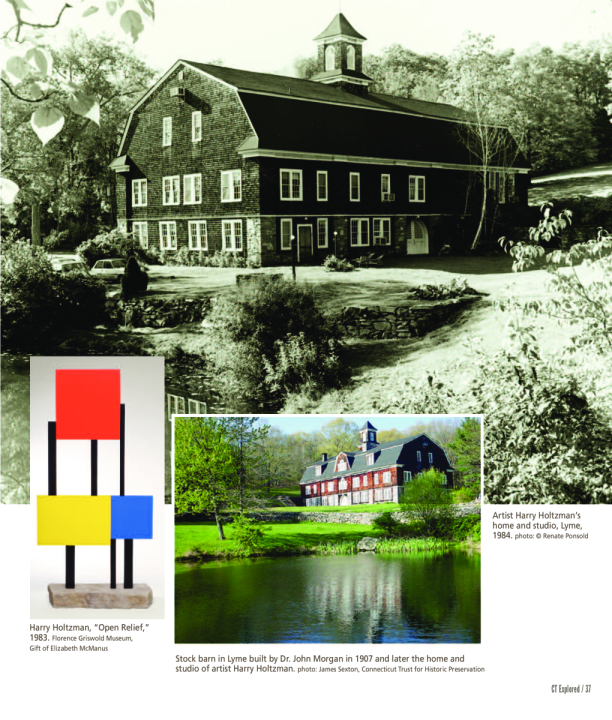(c) Connecticut Explored Inc. Spring 2018
SUBSCRIBE/BUY THE ISSUE!
The size and scale of a deteriorating early 20th-century barn for sale not far from the Connecticut River ferry in Hadlyme attracted abstract artist Harry Holtzman on a visit to the area in 1962. Despite the brambles blocking the doorways, he decided within days to purchase the abandoned shingle-and-stone structure on a 3.4-acre plot for 10 dollars from then-Connecticut State Police Commissioner Leo J. Mulcahy.
Holtzman spent more than a year transforming the 100-by-50-by-64-foot barn, which had sweeping views of the surrounding meadows and rock-strewn hillsides, into a combined living and studio space. The calving pen on the first floor became a kitchen, the horse stalls on the second floor became a living room and studio, and the upper hayloft provided storage space. He added huge stone fireplaces in each of three outsized living areas, using the hay chute as a central flue. Holtzman called his reclaimed Hadlyme home “Bull Run Hill.” He lived there from 1962 until his death in 1987.
The barn dates back to 1907 when Dr. John Morgan, a prominent Boston eye specialist, constructed it on his country estate to house his dairy cows and prize racehorses. The architect is unknown. Holtzman’s family members attribute the gambrel-roofed structure with its distinctive dormers and Palladian windows to renowned New York architect Stanford White, citing similarities to a White-designed barn in Newport to justify their claim. But evidence does not support this assertion. Architect and Stanford White biographer (and the architect’s great-grandson) Samuel White notes that his great-grandfather did not undertake residential projects in his later years, that there are no plans for the barn in his papers and no evidence that he worked in Lyme, and that his correspondence includes no communication with Morgan.
Dr. Morgan, a house-builder’s son who grew up in Hadlyme, was 62 when he added the massive stock barn to his estate. He had been raising trotting horses for 30 years. His interest in “runner-horses” developed during his time in Middletown, where he opened a practice after completing a medical degree at Yale in 1869.Harness racing became a wildly popular sport in Connecticut after the Civil War, and in 1873 a track opened at the Charter Oak Park in Hartford. A directory of U.S. trotting horse owners listed Dr. Morgan of Middletown in 1888.
Morgan’s family, like that of his wife Antoinette Comstock Morgan, had deep roots in the Lyme-East Haddam area. The couple had no children and began buying property in Hadlyme even before Morgan moved his medical practice from Middletown to Boston in 1895. There his professional reputation grew and his financial investments diversified, and in 1907 he became a director of the Exchange Trust Company, one of Boston’s newest banks.
His costly improvements to a century-old house in Hadlyme that same year became newsworthy. The Hartford Courantreported on October 26 that Morgan had “employed a large force of men on his place here and made it one of the most attractive homes in New London County.” The article also noted that he “has expended several hundred dollars on the road leading to his magnificent residence” and is “building a barn with sufficient capacity to accommodate about a hundred head of cattle.”
Two years later Dr. Morgan suddenly became a millionaire when rich deposits of copper were discovered on a 2,200-acre property in Jamaica he had bought on speculation. “It is just sheer luck that I should strike it so rich,” he said. But by the time Morgan retired to his Connecticut farm in 1915, his investments were over-extended. When he died suddenly in Hadlyme at age 75 in 1920, his wealth had evaporated. A decade later his widow Antoinette Morgan sold the barn and a 10-acre parcel for “one and other dollars” to Frank S. Preston.
Twenty years after Holtzman purchased the stock barn, he converted its third-floor hayloft into an expansive studio. There he created a series of signature large-scale sculptures in wood and stone that combined bold primary colors with grids of black lines to evoke the work of Dutch artist Piet Mondrian. Holtzman had known Mondrian in Paris half a century earlier and had collected his works and edited his writings while living in Lyme. Rocks gathered nearby serve as rustic pedestals to anchor his abstract constructions in the Connecticut landscape. Holtzman’s family put the three-story barn with 11 acres and a scenic trout pond on the market in 1995 for $1.195 million. Today the elegant cupola-topped structure remains a private home.
Carolyn Wakeman is editor of From the Archives, the Florence Griswold Museum’s history blog. She tells the story of artist Fidelia Bridges’s connection to Old Lyme in Episode 36 of Grating the Nutmeg(gratingthenutmeg.libsyn.com or ctexplored.org/listen).

